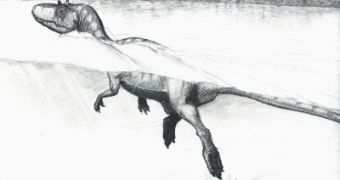Apparently, dinosaurs have been linked to the land. But a decade ago, researchers discovered the fossils of Suchomimus, a therapod (T-rex like) dinosaur from Central Africa, which 100 million years ago clearly fished with its crocodile-like snout.
But all these are suppositions, as nothing about the behavior of that dinosaur is known.
Now, researchers led by Rub?n Ezquerra, Fundaci?n Patrimonio Paleontol?gico de La Rioja, Spain, have discovered an extraordinary underwater trackway of 12 consecutive prints offering the most compelling proof by now that some dinosaurs could swim. The 15-meter (50 ft) long trackway, found in La Virgen del Campo track site in Spain's Cameros Basin, belonged to a non-feathered therapod dinosaur (thus related to Suchomimus).
The Cameros Basin is famous for its abundance of terrestrial dinosaur trackways from early Cretaceous (the last Dinosaur era), 125 million years old. The trackway was made of 6 sandstone preserved asymmetrical pairs of 2-3 scratch marks each.
Each mark was on average 50 cm (1.5 ft) long and 15 cm (0.5 ft) wide, with a spacing between them of 243-271 cm (8-9 ft). "The S-shaped prints paint a picture of a large floating animal clawing the sediment as it swam in approximately 3.2 meters of water", said co-author Loic Costeur, Laboratoire de Plan?tologie et G?odynamique de Nantes, Universit? de Nantes, France.
Ripple marks reveal the dinosaur advanced against a current, trying to keep a straight path. "The dinosaur swam with alternating movements of the two hind limbs, a pelvic paddle swimming motion. It is a swimming style of amplified walking with movements similar to those used by modern bipeds, including aquatic birds." said Costeur.
This is the first evidence of swimming in dinosaurs. Several earlier findings were just preserved tracks of walking in lower layers of sediment. "The trackway at La Virgen del Campo opens the door to several new areas of research. New biomechanical modeling will increase our understanding of dinosaur physiology and physical capabilities, as well as our view of the ecological niches in which they lived" , Costeur said.

 14 DAY TRIAL //
14 DAY TRIAL //